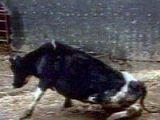Crazy cows are going to get a chance! Scientists could slow the progress of "mad cow disease" by genetically impeding protein synthesis in the brain.
Experiments in mice with scrapie - a disease similar to CJD (Creutzfeldt- Jakob disease) in humans and BSE (bovine spongiform encephalopathy "mad cow disease") in cattle showed that the life-extending treatment works. However, it will take years for the method to be introduced to medicine.
The German team used a method called RNA interference, cutting back the production of PrP-C protein in mice. RNA is related to the genetic molecule DNA. A special RNA type, siRNAs, can attach themselves to specific DNA stretch, preventing these from being 'read', thus the protein encoded to be produced. These shut down the production of proteins that go awry in prion disease. Prion proteins are very similar to healthy proteins, but have a slightly different shape.
When healthy proteins come into contact with the prions, they change their shape and become diseased as well. The result is an irresistible chain reaction. Finally, more and more malformed prion proteins are stored in the brain, thereby destroying brain tissue. Prion diseases are very unusual because the pathogens are apparently neither viruses nor bacteria, being simply protein molecules (the prions). It is even more peculiar: exactly the same prion proteins occur in healthy animals.
Prion diseases are always fatal, often - however - not until months after the outbreak of the disease and till now there is no cure. The researchers reasoned that shutting down healthy protein production using siRNAs would break the chain of events by depriving diseased prions of their ability to spread. Mice scrapie is caused by an abnormal prion protein known as PrP-Scr, whereas the normal variant is PrP-C. PrP-C seems to have a protective effect in diseases like a stroke.
Interestingly, mice which cannot produce any PrP-C seem to be completely healthy. "If brain cells are to produce siRNAs, you have to smuggle in the corresponding gene," says Professor Kretschmar, director of the Prion Centre of Munich's Ludwig Maximilian University. "But presumably we'll never manage to equip all the cells in the brain with this gene."
The scientists also need to find out how many cells they have to genetically block to treat scrapie or other prion diseases successfully. "We modified the brain cells of mice in such a way that they were able to produce siRNAs in place of the 'healthy' PrP-C protein," explains Professor Alexander Pfeifer, director of the Institute of Pharmacology of the University of Bonn.
If only a few cells could produce siRNAs, the mice died at almost the same time as the control mice, i.e. on average after 170 days. But the mice treated with the siRNA in 97 % of their brain lived much longer - for up to 230 days. "Basically siRNAs seem to be a promising therapeutic option for scrapie, CJD or BSE," Professor Pfeifer emphasizes. "However, it will take years before the method can be used on human beings."
The method can be used to breed cattle which cannot produce any PrP-C and would be resistant to BSE.
Dr Qingzhong Kong, an expert in prion diseases at the Case Western Reserve University in the US, said: "Much more research is needed before RNA interference can be harnessed to treat prion disease." A big hurdle was getting the siRNA safely into the correct cells. "These treatments also carry the risk of upsetting the immune system and blocking non-target genes", he added.

 14 DAY TRIAL //
14 DAY TRIAL // 
